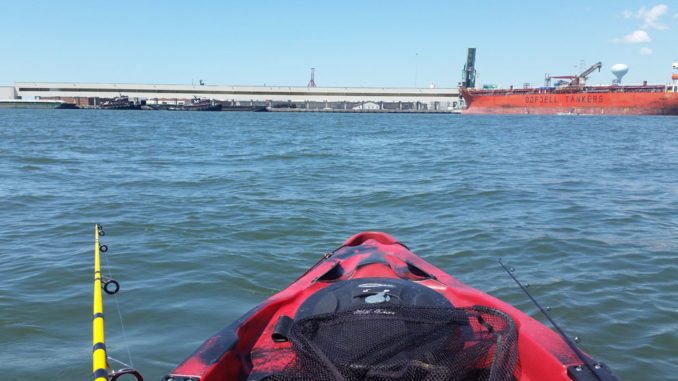
Kayaks, canoes must give ground on the water
I headed out in my Old Town Predator 13 with the intention of drifting along the western shoreline of Radio Island from the turning basin inside Beaufort Inlet. I have fished the area many times from a kayak. Barges, tow boats and occasional large ships pass through regularly. Whether in a paddle-powered craft or a small skiff, you always have to be wary of the larger vessels.
I dropped anchor in about 25 feet of water and used the anchor as a drag. In other words, I wanted to drift, just not as fast as the current was taking me.
After catching a few pinfish and croaker, I proceeded to put together some cut bait. First you catch the little fish, then you use the little fish to catch the bigger fish. The plan was working well.
As I approached the end of the island, maybe 50 to 70 yards off the bank, my rod bent double and line screamed off the reel. I had hold of something big.
I quickly gathered the anchor line from the trolley and pulled the anchor in while using my paddle as a rudder to turn the kayak. The rod remained steadfast in the Scotty holder attached to the mounting plate, although the line continued to sing as it was pulled from the reel.
After getting turned in the direction the fish was swimming, it was time to grab the rod and hold on. I slowly tightened the drag as the kayak gained momentum. Surely, I would be able to tire whatever was on the end as it pulled the kayak. Not only was it pulling the kayak, it was pulling the kayak against the current.
At this point, adrenaline was overwhelming me, and the excitement was pure. All would have been fine had the fish hugged the shoreline; instead, it headed towards the deep channel.
I only made slight progress in trying to gather line back on the reel, having no success getting the fish turned. It was going where it wanted to go, and I was not going to have any say in the matter.
The ship lanes were busy with large boats and even a dredging vessel, and the fish headed right into their paths. I either had to get the fish turned, get the fish to the boat or cut the line. Big boats and kayaks do not mix well on a busy weekend with a decent-sized chop mixing with overpowering boat wakes.
I tightened the drag as far as it would go and attempted to get the fish to come up to the surface. Just as I felt like I could see what was taking me for a sleigh ride, the 80-pound line snapped, whipping the rod upward and causing a sudden imbalance with me pulling hard on a now free rod.
Had I been in safer waters, I may have been able to bring the fish in, but under the circumstances, I had to think about safety as well.
The Rules of the Road are there for a purpose; safety. The Rules of the Road are the common name for the laws and regulations governing water vessels and who has what rights. Unlike on land where pedestrians have the right of way due to their size and lack of mobility, the larger vessels have the right of way in the water. Really large boats and ships tend to take up a lot of water and need room and deep channels in order to maneuver.
While a kayak or canoe may not be the fastest boat on the water, large boats can not stop or turn nearly as quickly. In other words, the smaller you are, the more you have to look out for yourself.
All vessels are required to try and avoid collision. That may mean preventive measures such as cutting a line before getting towed between the buoys of a shipping channel.
All vessels under oar or paddle are required to have some sort of light ready to signal a potential collision as well. Another way to signal to larger vessels is with a high-pitched whistle. The whistle can break through the low drum of large engines and motors that can make it hard to hear otherwise.
Safety is the top priority. I can go back and try to catch the fish again later.



Be the first to comment